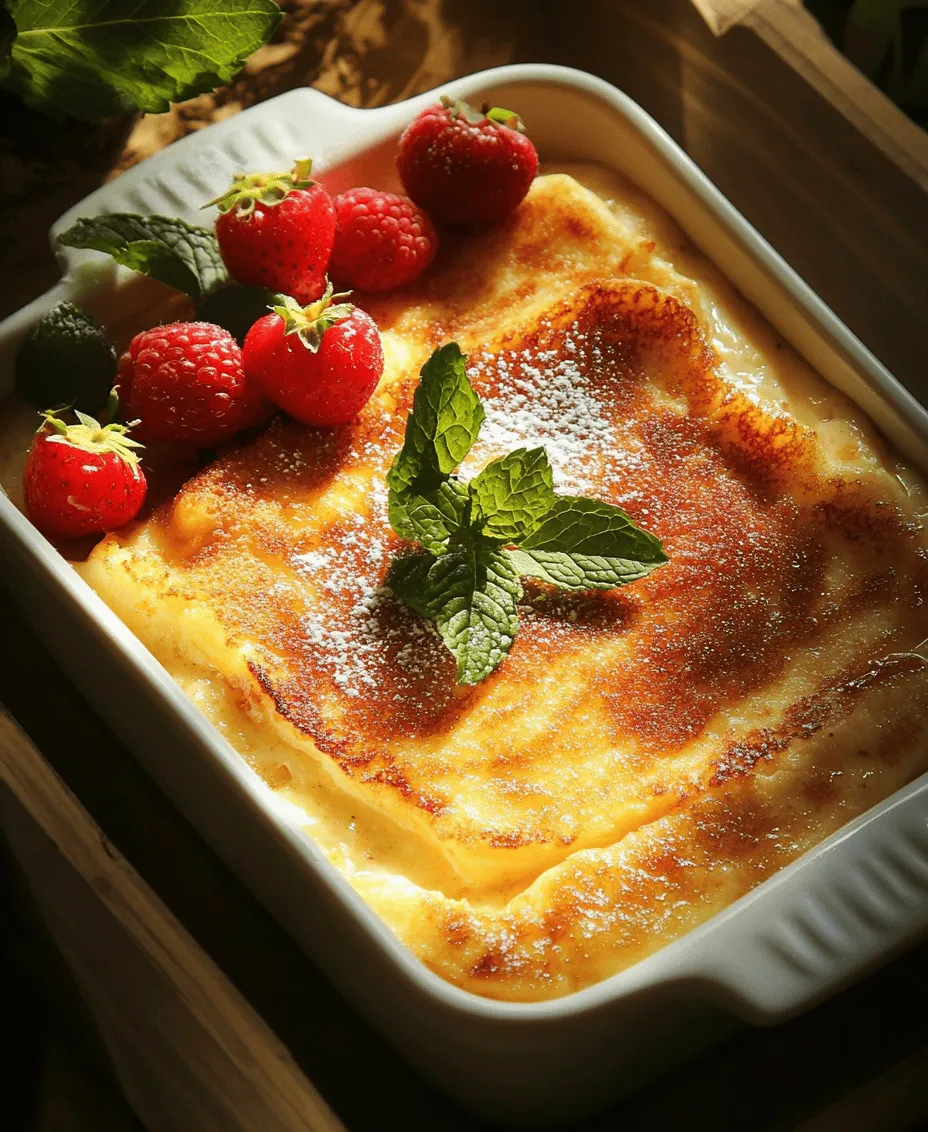When it comes to breakfast, few dishes can rival the indulgence of Overnight Crème Brûlée French Toast. This culinary delight marries the rich, velvety flavors of classic crème brûlée with the comforting, eggy goodness of French toast, creating a dish that is both decadent and satisfying. Imagine waking up to the aroma of caramelized sugar wafting through your kitchen, inviting you to indulge in a breakfast that feels like a special occasion, no matter the day of the week.
This recipe is perfect for those who want to impress guests or treat themselves to a gourmet breakfast without the hassle of morning cooking. By preparing it the night before, you can simply pop it in the oven in the morning, allowing you to enjoy a leisurely start to your day while still serving up an impressive meal. In this article, we will explore the detailed steps to create this delightful dish, including an overview of the key ingredients, preparation techniques, and tips for achieving the perfect crème brûlée French toast.
Understanding the Ingredients
To create the best Overnight Crème Brûlée French Toast, it is essential to understand the role of each ingredient. The quality and type of ingredients you choose can significantly influence the final outcome of the dish.
Brioche or Challah Bread
The foundation of any French toast is the bread, and for this recipe, brioche or challah are the ideal choices. Both types of bread are enriched with eggs and butter, giving them a tender crumb and a slightly sweet flavor. Brioche is known for its buttery richness, while challah offers a slightly denser texture with a hint of sweetness. The goal is to use a bread that can soak up the custard mixture without falling apart, ensuring a deliciously creamy interior once baked.
The Role of Eggs in the Recipe
Eggs are a crucial component of the custard mixture that binds the bread together and provides structure. In this recipe, large eggs are used to create a rich and creamy custard. The proteins in the eggs coagulate during baking, resulting in a custard-like texture that is characteristic of crème brûlée. Additionally, eggs contribute to the overall flavor and richness of the dish, making them an indispensable ingredient.
Importance of Whole Milk and Heavy Cream
To achieve the signature creaminess of crème brûlée, both whole milk and heavy cream are incorporated into the custard mixture. Whole milk provides a balance of creaminess and lightness, while heavy cream elevates the richness and smooth texture. This combination creates a delightful custard that envelops the bread, resulting in a luscious and satisfying breakfast treat.
Sweeteners: Granulated Sugar vs. Brown Sugar
When it comes to sweetening your custard, you have options. Granulated sugar is the traditional choice, providing a clean sweetness that complements the other flavors. Alternatively, brown sugar can be used for a deeper, more caramel-like flavor profile. The molasses in brown sugar adds complexity to the dish, enhancing the overall taste experience. Depending on your preference, you can choose either or even combine both for a balanced sweetness.
Flavor Enhancements: Vanilla Extract and Ground Cinnamon
To elevate the flavor of your Overnight Crème Brûlée French Toast, vanilla extract and ground cinnamon are key ingredients. Pure vanilla extract adds a warm, aromatic sweetness that enhances the custard, while cinnamon introduces a hint of spice that rounds out the flavor profile. Together, these ingredients create a comforting and inviting aroma that will have everyone eagerly anticipating breakfast.
The Role of Salt in Balancing Sweetness
While salt may seem like an unusual addition to a sweet dish, it plays a vital role in balancing flavors. A pinch of salt enhances the sweetness of the sugar and elevates the overall flavor of the custard. It helps to bring out the richness of the cream and the warmth of the spices, ensuring that no single flavor dominates the dish.
Preparation Steps for Overnight Crème Brûlée French Toast
Now that we have a thorough understanding of the key ingredients, it’s time to dive into the preparation process. Here are the essential steps to create your Overnight Crème Brûlée French Toast.
Preparing the Bread: Best Practices for Slicing and Arranging
The first step in preparing your Overnight Crème Brûlée French Toast is to slice the bread. For optimal results, use a serrated knife to cut the brioche or challah into thick slices, approximately 1 to 1.5 inches in thickness. This thickness allows the bread to soak up the custard without becoming overly soggy.
Once sliced, arrange the pieces of bread in a greased baking dish, either in a single layer or slightly overlapping, depending on the size of your dish. You can choose to arrange the slices vertically or horizontally, allowing for a beautiful presentation when baked. If desired, you can also sprinkle some cinnamon or sugar between the layers for added flavor.
Crafting the Custard: Techniques for Whisking and Combining Ingredients
With the bread prepared, it’s time to craft the custard. In a large mixing bowl, combine the eggs, whole milk, heavy cream, granulated sugar (or brown sugar), vanilla extract, ground cinnamon, and a pinch of salt. Using a whisk, beat the mixture until well combined and slightly frothy. This process aerates the eggs and ensures that all ingredients are evenly incorporated.
When whisking, be careful not to overbeat the mixture, as this can create excessive bubbles that may affect the texture of the custard. Aim for a smooth and creamy consistency that will envelop the bread and create that signature crème brûlée texture.
Combining Bread and Custard: Ensuring Even Soaking
Once your custard is ready, pour it evenly over the arranged bread slices in the baking dish. To ensure that each piece of bread is evenly soaked, gently press down on the slices with a spatula or your hands, allowing the custard to penetrate the bread. This step is crucial for achieving that creamy, custard-like interior.
After all the bread is soaked, cover the baking dish tightly with plastic wrap or aluminum foil. This will prevent the custard from drying out as it chills and allows the flavors to meld together overnight.
Covering and Refrigerating: Importance of Chilling for Flavor Development
Refrigerate the covered baking dish for at least 8 hours, or overnight if possible. This chilling process not only allows the bread to soak up the custard thoroughly but also enhances the flavors, creating a more harmonious and delicious dish. The longer you allow it to chill, the more pronounced the flavors will become, resulting in a truly indulgent breakfast experience.
With these preparation steps completed, you’re well on your way to creating a stunning Overnight Crème Brûlée French Toast that will impress family and friends alike. In the next section, we will discuss the baking process, ensuring that your creation turns out perfectly every time.
Stay tuned as we explore the final steps to transform your overnight masterpiece into a golden, caramelized delight that will tantalize your taste buds and elevate your breakfast game to new heights.

Prepping Your Oven: Proper Preheating Techniques
Before you embark on baking your Overnight Crème Brûlée French Toast, it’s essential to ensure your oven is properly preheated. This step is crucial for achieving even cooking and the best possible texture. Set your oven to 350°F (175°C) and allow it to preheat for at least 15-20 minutes. This ensures that the heat is uniformly distributed throughout the oven, allowing your French toast to bake evenly without developing a soggy texture.
Using an oven thermometer can be beneficial, as it provides an accurate reading of your oven’s internal temperature. Most home ovens can have fluctuations in temperature settings, which can affect the baking process. Ensuring that your oven is at the correct temperature before you put in your dish will help you achieve that perfect golden-brown finish and soft, custardy interior.
Baking Process: How to Achieve the Perfect Texture and Color
Once your oven is preheated, it’s time to bake your French toast. Carefully place the prepared baking dish in the center of the oven. Baking typically takes 35-45 minutes, but keep an eye on it after the first 30 minutes. The goal is to achieve a puffed-up, golden exterior while maintaining a soft, custard-like interior.
To check for doneness, gently insert a knife into the center of the dish. If it comes out clean, your French toast is ready. If it’s still wet or runny, allow it to bake for an additional 5-10 minutes. Another indicator of doneness is the color; it should have a beautiful golden hue. If the top browns too quickly, you can cover it loosely with aluminum foil to prevent burning while the center finishes cooking.
Understanding Caramelization: Tips for Achieving a Golden Brown Finish
Caramelization is what gives your crème brûlée French toast its signature flavor and rich, golden color. Achieving the right caramelization requires patience and the right techniques. Once your French toast is baked, it’s time to prepare the sugar topping.
Sprinkle an even layer of granulated sugar over the surface of the baked French toast. It’s crucial to use a fine granulated sugar, as it melts more evenly and creates a smoother caramel layer.
Using a kitchen torch is the best way to caramelize the sugar. Hold the torch about 1-2 inches above the sugar and move it in a circular motion to evenly distribute the heat. Watch closely, as sugar can burn quickly. As soon as the sugar begins to melt and bubble, keep moving the torch until you achieve a beautiful, deep caramel color. If you don’t have a torch, you can place the dish under a broiler for a couple of minutes, but be cautious and watch it closely to avoid burning.
Finishing Touches and Serving Suggestions
After achieving that perfect caramelized top, it’s time to let your dish cool slightly before serving. Allowing the Overnight Crème Brûlée French Toast to cool for about 5-10 minutes is essential; this helps the caramel set and makes it easier to cut and serve.
Using a Kitchen Torch: Techniques for Perfectly Brûléed Sugar
When using a kitchen torch, remember a few key techniques:
1. Distance: Keep the torch a safe distance from the sugar to prevent it from burning too quickly.
2. Movement: Always keep the torch moving to avoid hotspots that can lead to uneven caramelization.
3. Layer: If you prefer a thicker caramel layer, you can repeat the sugar process after the first layer hardens, giving you a more substantial crunch.
Garnishing Ideas: Enhancing Presentation with Fresh Berries and Mint Leaves
Presentation is key when serving Overnight Crème Brûlée French Toast. Enhance its beauty and flavor by garnishing with fresh berries such as strawberries, blueberries, or raspberries. These fruits provide a lovely contrast to the rich custard and sweet caramel.
Adding a sprig of fresh mint not only adds a pop of color but also a refreshing aroma. A dusting of powdered sugar on top can also elevate the presentation, making it look restaurant-worthy. For added indulgence, serve with a dollop of whipped cream or a scoop of vanilla ice cream for a decadent treat.
Variations on the Classic Recipe
While the classic Overnight Crème Brûlée French Toast is delightful as is, consider these variations to customize the dish further.
Alternative Bread Options: Exploring Other Choices Beyond Brioche and Challah
While brioche and challah are popular choices for this recipe due to their richness and ability to soak up the custard, feel free to experiment with other types of bread. Sourdough can add a tangy twist, while whole grain bread offers a nutty flavor.
You can also try using croissants for a flakier texture or even gluten-free bread options for those with dietary restrictions. Keep in mind that the type of bread you choose will affect the final flavor and texture, so select one that complements your taste preferences.
Flavor Variations: Incorporating Different Extracts and Spices
To give your French toast an exciting twist, consider adding different flavorings to the custard mixture. A splash of vanilla extract is classic, but you can also experiment with almond extract, orange zest, or even a hint of coconut.
For a spiced version, consider adding cinnamon or nutmeg to the custard. These warm spices can elevate the dish and make it perfect for cozy mornings or holiday gatherings.
Toppings and Add-ins: Creative Ways to Customize Your French Toast
Get creative with toppings and add-ins to make your Overnight Crème Brûlée French Toast truly your own. Consider adding chocolate chips, nuts, or dried fruits to the bread mixture before soaking it in the custard.
For an even sweeter touch, drizzle with maple syrup or honey when serving. A sprinkle of toasted coconut can also enhance the tropical twist if you’ve added coconut extract.
Nutritional Insights
Understanding the nutritional profile of your Overnight Crème Brûlée French Toast can help you enjoy it mindfully.
Caloric Breakdown of Overnight Crème Brûlée French Toast
A single serving of Overnight Crème Brûlée French Toast typically contains around 400-600 calories, depending on the portion size and specific ingredients used. This includes the custard layer and the sugar topping, which contribute to the overall calorie count.
Healthier Substitutions: Lower-Calorie and Dairy-Free Options
If you’re looking to lighten the dish, consider using lower-calorie alternatives. Substitute whole milk with almond milk or oat milk, and use egg substitutes or flaxseed meal mixed with water for a more health-conscious option.
Additionally, you can reduce the amount of sugar in the custard and opt for a sugar substitute that maintains the sweetness without the calories.
Understanding Portion Sizes: Serving Suggestions for Balanced Eating
When serving Overnight Crème Brûlée French Toast, consider portion sizes to maintain balance in your meal. A typical serving is about one to two pieces, but accompanying it with fresh fruit and a protein source, such as Greek yogurt or scrambled eggs, can create a well-rounded breakfast plate.
Conclusion: The Joy of Overnight Crème Brûlée French Toast
In conclusion, Overnight Crème Brûlée French Toast is more than just a breakfast dish; it’s an experience that brings joy to gatherings and brightens mornings. By following the simple steps outlined above, you can create a delectable meal that balances flavors and textures beautifully. Whether you choose to stick with the classic recipe or explore variations, this dish is sure to become a beloved staple in your breakfast repertoire. Enjoy the rewarding process of making this delightful treat and share it with those you love, creating delicious memories around the breakfast table.


